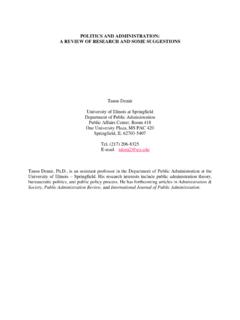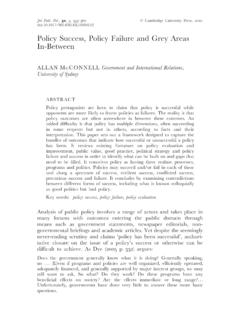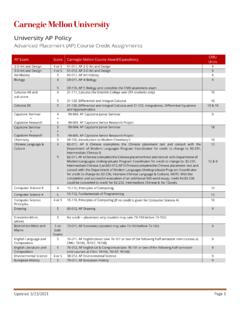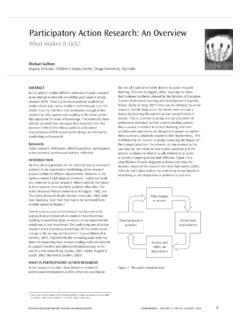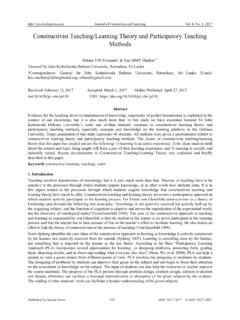Transcription of Problem Solving - SAGE Publications Inc
1 203 11 Problem Solving T eam Problem Solving is studied using three different approaches: how teams go about Solving their problems, what types of behavior con-tribute to effective Problem Solving , and what techniques can be used to improve group Problem Solving . Teams should base their Problem - Solving approaches on a rational model of the process that includes six stages: Problem definition, evaluation of the Problem , generating alternatives, selecting a solution, implementation, and evaluation of the results. In prac-tice, however, this rational approach is rarely followed, and teams often find themselves developing solutions before they understand the problems.
2 At each stage of the Problem - Solving process, teams can use a number of techniques to improve their Problem - Solving abilities. Using these tech-niques helps teams be more effective Problem solvers. Learning Objectives1. How do teams typically solve problems?2. What factors help improve a team s ability to solve problems?3. What factors disrupt a team s ability to solve problems?4. What are the main steps in the rational approach to Problem Solving ?5. How do the characteristics of the Problem , team, and environment affect the way a group analyzes a Problem ?
3 204 Issues Teams Face Approaches to Problem Solving A Problem is a dilemma with no apparent solution, an undesirable situation without a way out, a question that cannot currently be answered, the differ-ence between the current situation and a desired state, or a situation team members must manage effectively (Pokras, 1995). The Problem can come from the environment or arise from the team. Problems often first surface for a team as symptoms that cause undesirable effects. In a work environment, a Problem for many teams is simply how to complete their tasks or assignments.
4 A team s assignment contains two primary problems: (1) determining the nature of the assignments and how to complete them and (2) managing problems and obstacles encountered when performing them. These obstacles may be technical issues, conflicting viewpoints, or interpersonal conflicts. The perfect way to solve a Problem is to define it and then decide how to solve it. This may seem obvious, but the biggest Problem teams have is generating solutions without first understanding the Problem . Defining and evaluating the Problem is the most difficult step for teams to perform.
5 The first step in Problem Solving is to discuss and document individual views until everyone agrees on the nature of the Problem (Pokras, 1995). Teams are often given ill-defined problems and undeveloped criteria for evaluating them. Teams need to challenge the definitions of the problems, searching for their root causes. They also need to define what successful resolutions would look like in order to evaluate alternative solutions. The result should be agreement on the issues that need resolution and clear statements of the Problem .
6 Teams may rush through the Problem definition stage, only to find that they have to return to it during the solution or implementation stage. This is a time-consuming approach to Problem Solving . Understanding as much as possible about a Problem at the beginning can reduce the overall time spent Solving the Problem . 6. What is the value of using a structured approach to generating and evaluating alternatives?7. What factors affect the implementation of a solution?8. Why should Problem - Solving teams use structured techniques to analyze and solve problems?
7 9. What are some of the techniques that teams can use to help in their Problem - Solving efforts? Problem Solving 205 Another common flaw is ignoring the final stage: evaluating the solu-tion. Often teams are created to solve problems but are not responsible for implementation or evaluation . evaluation is ignored because no one wants to present negative information to superiors. Rather than learning from mistakes made, the mistakes are hidden from the team and organization. As a result, they are often repeated because of lack of feedback. There are three approaches to team Problem Solving : descriptive, which examines how teams solve problems; functional, which identifies the behaviors of effective Problem Solving ; and prescriptive, which recommends techniques and approaches to improve team Problem Solving (Beebe & Masterson, 1994).
8 Descriptive Approach: How Teams Solve Problems The descriptive approach examines how teams solve problems. Researchers focus on different aspects of the group process in order to understand the Problem - Solving process. These different perspectives offer alternative ways of understanding the process. One perspective using the descriptive approach is to identify the stages a team goes through during Problem Solving (Beebe & Masterson, 1994). This approach is similar to the stages of group development discussed in Chapter 3. The four stages a team uses when Solving a Problem are form-ing, storming, norming, and performing.
9 In the forming stage, the team examines the Problem and tries to better understand the issues related to it. The storming stage is a time of conflict, when different definitions of the Problem and preliminary solutions are discussed. Often, the team jumps ahead to arguing about solutions before it has reached agreement on the Problem , so it must return to the Problem definition stage to resolve this conflict. In the norming stage, the team develops methods for analyzing the Problem , generating alternatives, and selecting a solution.
10 The establishment of these methods and other norms about how to operate helps the group work together effectively. In the performing stage, these methods are used to solve the Problem and develop plans to implement the solution. Rather than going through Problem - Solving stages, many teams start the Problem - Solving process by generating solutions. Teams generate alterna-tives and select solutions in a variety of ways. Strategies include selecting a solution at random, voting for the best solution, taking turns suggesting each member s favorite solution, trying to demonstrate that a solution is correct, or inventing novel solutions (Laughlin & Hollingshead, 1995).












